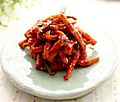Korean radish facts for kids
Quick facts for kids MuKorean radish |
|
|---|---|
 |
|
| Genus | Raphanus |
| Species | R. raphanistrum |
| Subspecies | R. raphanistrum subsp. sativus |
| Cultivar group | White radish |
| Cultivar | Mu / Korean radish |
| Origin | Korea |
| Korean name | |
| Hangul |
무
|
|---|---|
| Revised Romanization | mu |
| McCune–Reischauer | mu |
| IPA | [mu] |
Mu or Korean radish is a special type of white radish that's super crunchy. Even though mu (무) can mean any radish in Korean, it usually refers to this specific Korean variety.
Korean radishes are short, strong, and thick. They often have a pale green color on the top half. They taste quite strong, have firm insides, and their leaves are soft. The leaves of Korean radishes are called mucheong (무청). People use these greens in many different dishes.
Contents
All About Korean Radish
What Does It Look Like?
Korean radishes are plants that grow for one or two years. People grow them mainly for their big taproots, which are the main part we eat. These roots are round and shaped like a cylinder. They usually weigh about 800 grams (almost 2 pounds). They are about 20 centimeters (8 inches) long and 7 to 8 centimeters (3 inches) wide. When picked at the right time, Korean radishes are crisp, a little peppery, and sweet.
The top part of the root grows underground. From there, long, oval-shaped leaves sprout out. These leaves are arranged in a circle, like a flower. White or light purple flowers grow on a tall stem from April to May. After the flowers, small pods grow, about 4 to 6 centimeters long. These pods have hard shells and reddish-brown seeds inside.
Growing Korean Radish
People started growing radishes in Korea a very long time ago, during the Three Kingdoms era. They were a super important crop during the Goryeo era too.
Today, radish is the most widely grown crop in South Korea. In 2015, about 70,000 hectares (that's like 173,000 acres) were used to grow radishes. Farmers harvested about 4.5 million tons of them! Korean radishes take about 3 months to grow fully. If stored properly in a cool, unfrozen place, radishes picked in the autumn can last until spring.
How Koreans Use Radish
Koreans use every part of the radish plant, from the root to the leaves. It's a key ingredient in many Korean soups and stews. It's also used to make a tasty broth for various dishes.
Radish Parts and Products
- Mucheong: These are the radish greens. They can be dried to make siraegi or used fresh in cooking.
- Mu-mallaengi: This means dried radish. People cut radishes into thin strips and then dry them in the sun.
- Musun: These are radish sprouts. They grow from radish seeds.
- Siraegi: This refers to dried radish greens or dried leaves from napa cabbage.
- Ssammu: This is a very thin radish slice that's pickled in vinegar, salt, and sugar. It's often used like a wrap for foods such as samgyeopsal or galbi.
Popular Radish Dishes
Korean radish is used in many delicious traditional dishes:
- Dongchimi: This is a type of water kimchi. It's made by pouring cooled, boiled water over sliced and salted radishes. Other ingredients like apples, pears, garlic, ginger, and chili seeds are often added in a bag.
- Kkakdugi: This is another type of kimchi. It's made with cubed and salted radishes. These are mixed with a spicy puree of red chili, scallions, pear, onion, and fish sauce.
- Mubap: This is a simple dish of rice mixed with sliced radishes. It's usually served with a seasoned soy sauce.
- Muguk: This is a type of soup. It's made by stir-frying slices of beef and radish in sesame oil. Then, water and soup soy sauce are added, and it's seasoned with salt and a little black pepper.
- Mu-mallaengi-muchim: This is a seasoned vegetable dish. It's made by mixing soaked dried radish (mu-mallaengi) with a spicy, flavorful sauce.
- Mu-namul: This is another seasoned vegetable dish. It's made by stir-frying thinly cut and lightly salted radish in sesame oil. Then, chopped scallions, minced garlic, and toasted sesame seeds are added.
- Mu-saengchae: This is a fresh, seasoned radish salad. Thinly cut radishes are seasoned with chili powder, fish sauce, salt, and other spices.
- Mussam: This is a type of roll or wrap. People wrap shredded vegetables inside thin, pickled radish paper (ssammu).
- Nabak-kimchi: This is a water kimchi similar to dongchimi. It uses thin, square slices of radish and napa cabbage. It's made with a mild chili powder-water and other fresh ingredients.
Images for kids
-
Drying mucheong (radish greens) to make siraegi
-
Ssammu (pickled radish paper for ssam)
-
Dongchimi (radish water kimchi)
-
Kkakdugi (radish kimchi)
-
Mu-jjanji (salted radish pickle)
-
Mu-jorim (braised radish)
-
Mussam (radish wraps)
-
Pickled radish served with Korean fried chicken













